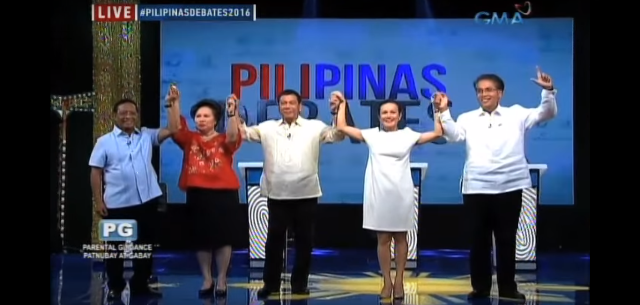First Election Debate Goes Pfft: Coverage Filled with Sound bytes and Pull Quotes
GIVEN THE media hype and hoopla surrounding the holding of the first debate, the program went pfft, with little excitement to engage. What substance could have been drawn out from the political exchange was weighed down by mechanics of the format and the burden of too many commercials.
The first leg of the presidential debates organized by the Commission on Elections (Comelec) in partnership with leading media organizations was held last February 21 at the Capitol University in Cagayan de Oro City, Mindanao. All five presidential candidates — Vice President Jejomar Binay, Senator Miriam Defensor-Santiago, Davao City Mayor Rodrigo Duterte, Senator Grace Poe, and former DILG Secretary Mar Roxas–participated.
The format of the debate was in itself limiting of extended exchange. Candidates were given only a minute and a half to answer questions from the moderators, and even less time to rebut their opponents. Candidates were given issues to discuss only by chance as each was asked to pick out the themes from a “fishbowl.” Candidates were questioned in pairs; each could then speak or “debate” only with one other candidate. The pairing was not based on anything substantive, such as known advocacies or disagreements.
The Comelec had assigned possible topics for the Mindanao debates in January, among them poverty, peace and order, and agricultural development. These issues were all taken up during the second and third rounds of the debate. But the media reports put more emphasis on the first round, which took up the track record and past performance in government of each candidate. Much of the coverage consisted mostly of pull quotes and sound bytes from this round, as the media gave short shrift to the succeeding rounds which focused on some of the most pressing issues in Mindanao, like the Bangsamoro Basic Law.
Same old, same old issues
During the first round, each candidate was asked questions on the controversial issues that have been hounding them: Binay’s assets and properties, Santiago’s health, Duterte’s foul language and a supposed criminal case, Poe’s relatively short stint in public service, and Roxas’ “unsatisfactory” performance as cabinet member.
Criticism of the debate format ran high in social media as netizens complained about the short time given to the candidates and the heavy exposure given to commercials. But the problematic mechanics of the debate were hardly noted by media reports.
ABS-CBN 2 and Mindanao-based media picked up on another angle by reporting on the dissatisfaction of the candidates themselves about the limited time given so they could present their platforms. Roxas and Duterte said as much in interviews after the debate.
GMA News Online and BusinessWorld did well by fact-checking the claims made by the candidates.
A number of facts and figures on budget, infrastructure and crime in Mindanao cited by the candidates were barely mentioned in the reports, much less verified. GMA News Online has produced a series of articles fact-checking candidates’s financial figures and statements on controversial issues:
- Fact Check: Did Region 11 get P19 billion while NCR got 64 percent of infra budget?
- Fact Check: Is the PNoy admin responsible for the Laguindingan Airport?
- Fact Check: Did Miriam’s son no longer run for another post?
- Fact Check: Can people with illnesses still run for president?
- Fact Check: ‘Hindi po totoo na ako ay maraming lupa’- Binay
BusinessWorld, meanwhile, published an infographic also fact-checking some of the candidates’ claims in the debate.
Notably, Mindanao-based media took a different tack by writing stories that did not rely heavily on the actual debate, but instead used Mindanao residents as sources who expressed their reactions to the event.
Mindanao Gold Star Daily, in particular, featured a report by correspondent Froilan Gallardo noting televiewers’ disappointment over the excessive commercials aired during the program, consuming more time from the actual debate itself which could have helped to make the exercise more meaningful in helping citizens appreciate the worthiness of those aspiring to lead them. This report also included citizen’s recommendations to improve the next debates.
Gallardo, in a report he wrote for MindaNews, quoted Mindanao residents who said that the candidates did not have a full grasp of Mindanao issues.
Meanwhile, Carolyn Arguillas, also from MindaNews reported that 48 minutes of the 2-hour debate were devoted to advertisements. Mindanews took note of “117 ad placements, seven of these campaign ads of the Presidential candidates, except Davao City Mayor Rodrigo Duterte, and three from the Commission on Elections (Comelec).”






Leave a Reply